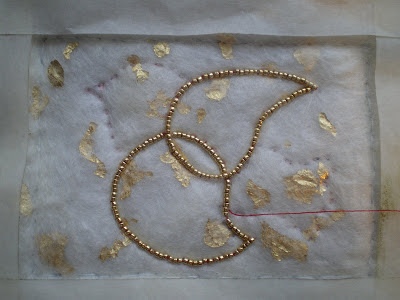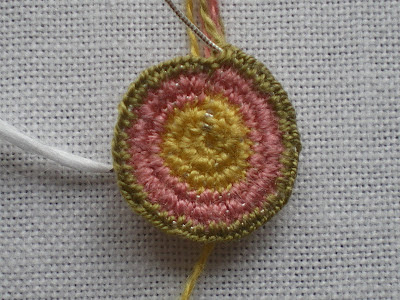Some months ago I received an email from Dr Clare Pollard, Assistant Keeper of Japanese Art at the
Ashmolean Museum. At the time Clare was preparing a catalogue for a loan exhibition of Japanese ornamental textiles of the Meiji era taking place in the autumn. Although Clare had done a fair amount of work on Meiji art she professed to not knowing as much about textiles and asked if I would be willing to visit the Ashmolean and have a look at the some of the embroideries. Needless to say, I jumped at the chance.

Silk tapestry wall hanging
Peacocks with paulownia, cherry, magnolia and peonies,
from a series One Hundred Flowers and One Hundred
Birds
in Late Spring and Early Summer
Kawashima Textile Company
Silk and metallic thread
c.1908
H 230 x W 362 cm
© Private Collection
A couple of weeks later, I found myself up close and personal with some of the exquisite embroideries in the collection. I was a little bit concerned that I would not be able to provide the level of expertise required for such a prestige exhibition and the style of the embroideries, which were created during the Meiji period (1868 – 1912) specifically for the export market, were distinctly different from the type of embroidery I am familiar with. However, I need not have worried; I was able to identify all of the stitches and techniques used and answer all of Clare’s questions.
Over the following weeks I provided Clare with notes about the stitches and techniques of Japanese embroidery to assist her in writing that section of the catalogue and edited some of the entries describing the details photographs of the embroideries.

Embroidered wall hanging
Cranes, wisteria and cycads
Ribbed silk (shioze) with embroidery in silk and metallic thread,
silk brocade border
c. 1905
H 201 x W 279 cm
© Ashmolean Museum, University of Oxford
During my visit to the Ashmolean, Clare had asked about my interest in Japanese embroidery and I had told her about my studies, my tutors and my fellow students. We discussed other ways in which
Japanese Embroidery UK might become involved in some of the events planned around the exhibition, in particular a study day that would coincide with the opening of the exhibition and an event called
The Big Stitch. Clare had asked if I would give a talk about Japanese embroidery on the study day. I have never given a talk and the idea filled me with dread so I asked if any of my tutors would like to do it. Unfortunately, the study day coincided with the start of an embroidery class and at first it looked like none of the tutors would be available that day. Then, much to my relief,
Jane said that she would be available and was happy to do it. Phew!
When Clare had first contacted me in April, the opening of the exhibition seems such a long time away but, as is always the way, time has flown by. On Thursday evening Jane and I attended the Private viewing of the Exhibition ahead of the official opening on Friday morning. Even though I had seen a few of the embroideries before, I was totally blown away by the splendour of the exhibition. I had view three or four framed embroideries and a couple of wall hangings. The hangings were spread on table and were not the largest or most impressive in the exhibition. When we walked into the gallery and saw the wall hangings beautifully hung and lit they looked spectacular. I think that Jane and I were in stitcher’s heaven.

Embroidered hanging scroll
Hawk on a snowy pine branch
Silk with embroidery in silk thread, paper
and silk brocade mount, wooden roller
Mid-1890s
H 137.5 x W 64 cm
© Kiyomizu-Sannenzaka Museum, Kyoto
The following morning we returned to the Ashmolean for the study day. There was to be a series of lectures all relating to the exhibition, culminating in Jane’s talk about the stitches and techniques. While Jane gave her talk, I would sit beside her and demonstrate. I thoroughly enjoyed the lectures but I could not stop thinking about our spot and all day I had a knot of anxiety in my stomach, while beside me Jane appeared to be as cool as a cucumber. During the afternoon, due to technical difficulties and extended question and answer sessions, the lectures over ran slightly. Finally, it came to our turn but only 30 minutes remained for our planned 1 hour talk and we knew that the event had to finish promptly to allow staff to set up for an evening event. It seemed like we had barely begun, when we told we must finish but Clare suggested that we move upstairs to the exhibition gallery and continue there. As Jane could not use the power point presentation she had prepared, she conducted a tour of the exhibition and explained the stitches in context. Meanwhile, I set up my frame in a corner of the gallery and fielded a barrage of questions and demonstrated time and time again how to make a twisted thread. Over an hour later, the crowd finally subsided and Jane and I were finished. Wow! What a day. It had not gone according to plan, but I don’t think that we could have planned it better. Jane was an absolute star!

Embroidered four-fold screen
Peacock and peahen
Probably by Nishimura Sōzaemon, Chisō
Silk with embroidery in silk and metallic
thread, wooden frame with lacquered decoration
1900 to c. 1910
H 172 x W 264 cm
© Kiyomizu-Sannenzaka Museum, Kyoto
I am truly honoured to have been involved in this exhibition, even if in a very small way. I’ve been telling friends and family that I am now a consultant to the Ashmolean Museum, Oxford ;-)
Threads of Silk and Gold continues until 27th January 2013 and Japanese Embroidery UK will be back at the Ashmolean on 1st December to take part in The Big Stitch.

Embroidered panel
Young woman reading a book illuminated
by orange light
Silk with embroidery in silk thread,
original
wood frame
With label ‘S. Nishimura’
c. 1890–1900
H 31.4 x W 24 cm
© Kiyomizu-Sannenzaka Museum, Kyoto
Happy Stitching


















































